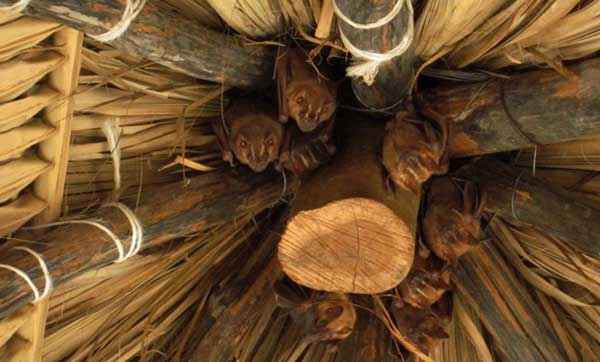Bat Heaven is in turbine-free Mexico
Administrator | Mar 07, 2013 | Comments 5

Eight lucky bats hang out in seaside palapa, Melaque Mexico. Photo by Jackie Sandiford, Courtenay B.C.
By Jim McPherson
In winter evenings I relax in my hammock under our seaside palapa to watch the sun set behind the jagged peaks that frame the bay in Melaque, Mexico. Here we are treated to a different skyscape every evening, and the lucky bats are treated to a turbine-free fly zone.
When I cast my eyes down from the sunset, I see a 12 inch circle of bat guano on the floor. When I look up to under the palapa’s peak, I see a small family of eight bats that have been hanging out all day, upside-down and motionless. Their eyes are wide open, awaiting the dusk.
About five minutes after the sun sinks behind the hills the bats begin to move, one by one. Ten minutes later they are all gone. When each bat is ready for the night, it crawls out between the dried palm fronds into the evening air and flits about, feasting on gourmet Mexican insects.
These Melaque bats are about the size of Ontario’s small Norway rat. They make a good contribution to insect control in the productive farmlands around Manzanillo, just as County bats harvest millions of flying insects from our farmlands at home.
But the bats in my Mexican palapa are much luckier than the bats in the County. Like the County, this part of Mexico has lots of agriculture and tourism, but unlike the County, and other parts of Mexico, this is Bat Heaven, because here there are no proposed infestations of Industrial Wind Turbines. (When a bat flies close to a wind turbine its lungs explode from the severe pressure differential.)
Why don’t the Ontario politicians from urban ridings seem to care that bats reduce the need for pesticides in Ontario’s agricultural countryside? Don’t they know that Industrial Wind Turbines explode bat lungs?
Jim McPherson
Milford
Filed Under: Letters and Opinion
About the Author:



































Right on, Mark. Turbines have no place at Ostrander Point. It’s greed that is driving this decision.
I think logic tells the reasonanble if there is doubt give the doubt to the apellant. We all know it is an important bird area. Why then place it there unless $$ rule. There is no dire need for this. It’s a money issue pure and simple.
Conclusions from Stantec’s Acoustic Bat Monitoring Report:
“The acoustic data would suggest that activity of long-distance migratory bats was not unusually high. The
majority of hoary and silver-haired bats appeared to have passed through the Study Area by the end of August. However, the eastern red bat was observed into mid-September, although in lower numbers.
Higher overall bat activity was observed at detectors that were closer to the shoreline. The activity along the shoreline was likely indicative of foraging bats and high activity levels may have been cause by multiple detections of individual bats.
Bat activity levels were much lower at the elevated detector MET-High, indicating that the majority of bat flight in the Study Area is occurring at lower elevations, below wind turbine blade sweep height.”
Acually, it is the other way around Donna. The Acoustic studies done at Ostrander Point showed a high passage rate of migrant bats during the fall. Mostly at blade height too.
The audio studies by Stantec on bats at Ostrander Point are the only ones that have been done there. They show found that there aren’t many bats there, and that they are mostly resident, not migratory. Bats follow the shoreline closely so turbines back from the shore should not affect them. Also part of the agreement with Gilead is that if there are more than 10 bats kills per turbine, they are to undertake mitigation action.
White Nose Syndrome is THE major threat to our hibernating bats, not wind turbines.
And Jim, we all know that Mexico is FAR from an environmental responsible or sustainable country!